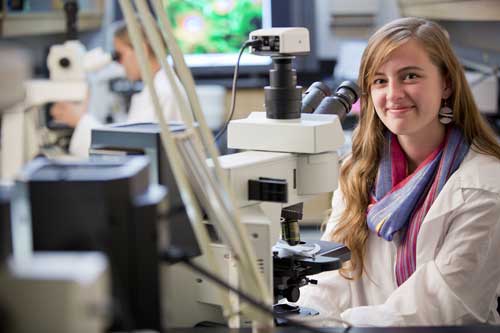University of Lethbridge students will benefit from a new training program recently announced by the Natural Sciences and Engineering Research Council of Canada (NSERC).
Over the next six years, the federal government, through NSERC, will invest more than $1.65 million at the University of Lethbridge to give young researchers the opportunity to learn the technical and professional skills that will prepare them for successful careers in science and engineering.

Through the Collaborative Research and Training Experience (CREATE) Program, U of L researchers in neuroscience and biological sciences will work with up to a dozen post-doctoral fellows, more than 20 graduate students and eight undergraduate trainees.
They will be cross-trained on a wide variety of approaches to biological systems research and will have access to state-of-the-art equipment, including magnetic resonance imaging, supercomputers, and a host of lab gear unique to the collection and analysis of genetic material, including DNA. The U of L project is one of four in Alberta and among 17 funded nationally.
"The core of our program is the training of graduate students to be productive team members, not just research subordinates," says Dr. Robert Sutherland, a neuroscience researcher at the Canadian Centre for Behavioural Neuroscience (CCBN) and the CREATE program principal investigator.
"Current postgraduate training programs at the U of L generally are characterized by a very high standard of science but they have been focused on a limited range of research approaches," says Sutherland. "Our program will provide a world-class training environment for students and post-doctoral trainees in the field of information processing in biological systems, integrating cell biology, dynamic imaging, and neuro-computation."
Sutherland adds that the U of L proposal is based on the idea that the next generation of innovators in life science must have a tool kit that contains methods for seeing a bigger research picture, in particular how molecules move within cells, how to measure the activity of large distributed networks of cells, and how to use theoretical computer models and apply them to their research.
"This training will contribute significantly to a new generation of Canadian neuro/life scientists who are equally at home with a microscope or microelectrode, as with a supercomputer. This combination is essential for innovation in this part of life science and in its application in the future," says Sutherland.
"This funding will be a big win for our students and our researchers," says Dr. Dan Weeks, the U of L's vice-president (research). "Our neuroscience and biological sciences programs already have a good track record of placing graduates in quality positions in the academic and research community. By adding even more value to the student experience with the CREATE program, we are making already-excellent programs better, and in a way that really helps our students move forward with their careers."
As well, Weeks says that by adding an undergraduate component to the program, students who are looking at a career in research can get a head start on that process.
"We are building a lot of research capacity here, and in unique and collaborative ways that wouldn't be possible at a larger university," says Weeks.
This is the second CREATE program at the U of L. In 2010, imaging science researchers received funding to support a program in advanced methods, education and training in hyperspectral science and technology (AMETHYST).
Roughly midway through the program, 20 students are currently in AMETHYST, which creates training environments linked directly with internships at over 35 collaborating agencies in industry and government, as well as other selected universities worldwide.
Within this program, graduate students have the opportunity to spend up to four months in organizations, such as NASA, the European Space Agency, the German Helmholtz Research Centres, and locally with the Blackbridge Group, a Lethbridge-based imaging company that is the world's fourth largest private satellite owner/operator.
In addition to class time and specific projects, undergraduate students who qualify for the AMETHYST program work with the co-operative education office on campus to manage work placements locally, nationally and internationally.
"NSERC's CREATE Program is providing a valuable experience for students and postdoctoral fellows to learn practical skills and to engage in cutting-edge, multidisciplinary and, in some cases, international research," says NSERC President Suzanne Fortier. "Exposing our trainees to an innovative, collaborative training environment will enable them to succeed in careers that contribute to the world's top research."
In its first two years (2009-11), the CREATE Program supported 40 teams of researchers and 1,513 students and postdoctoral fellows. In this round of funding, more than $28 million will be invested in 17 projects.
